Explore the workings, design considerations, and applications of fluxgate sensors. Dive into their advancements and future potential.

Introduction to Fluxgate Sensors
Fluxgate sensors, often overlooked in discussions of magnetic field detection, play a pivotal role in numerous scientific, technical, and industrial applications. Essentially, a fluxgate sensor is an advanced device for measuring magnetic fields with impressive precision and sensitivity.
The Science Behind Fluxgate Sensors
At its core, a fluxgate sensor leverages the principle of magnetic saturation. The sensor comprises a magnetically soft ferromagnetic core around which two coils of wire are wound. The primary coil, subjected to a high-frequency alternating current, induces a magnetic field in the core. When an external magnetic field is present, it causes a disturbance in the symmetry of the induced magnetic field, which is picked up by the secondary coil and used to infer the intensity of the external field.
Working Principle of Fluxgate Sensors
A fluxgate sensor operates using the property of ferromagnetic materials known as hysteresis. This property refers to the way these materials react to changes in an external magnetic field. Specifically, the ferromagnetic core in the sensor is ‘saturated’ at high magnetic fields and shows a non-linear relationship with the applied field, a behavior which forms the basis of fluxgate sensing.
Importantly, this phenomenon is frequency-dependent. In a typical setup, the primary winding is driven at a frequency that brings the core into saturation twice per cycle. The secondary winding, in turn, detects any asymmetry in the core’s response to this drive signal, which is indicative of an external magnetic field.
Key Components of Fluxgate Sensors
- Primary winding: This is responsible for inducing the alternating magnetic field in the sensor’s core. It’s typically driven by a high-frequency alternating current.
- Secondary winding: This component detects the alterations in the core’s magnetic field that arise from the presence of an external field.
- Ferromagnetic core: A magnetically soft core that is used to enhance the sensor’s sensitivity. The core’s magnetic saturation properties are exploited in the fluxgate sensing process.
Next, we’ll delve deeper into the design considerations, key applications, and advancements of fluxgate sensors.
Design Considerations of Fluxgate Sensors
Designing a fluxgate sensor involves balancing several crucial factors. The choice of core material is critical, as it must exhibit suitable saturation characteristics and high permeability. The sensor’s overall design and the winding techniques used also significantly impact its sensitivity and noise performance.
Additionally, the drive frequency of the primary winding must be chosen carefully. A higher frequency can lead to greater sensitivity, but it may also increase the sensor’s power consumption and heat generation.
Applications of Fluxgate Sensors
Fluxgate sensors are widely used in various fields due to their high sensitivity and precision. In geophysics, they enable precise measurements of the Earth’s magnetic field for oil exploration and archaeological studies. They are also used in space probes to study planetary magnetic fields.
- Navigation Systems: Fluxgate compasses, capable of detecting the Earth’s magnetic field, serve as reliable navigation aids in ships and aircraft.
- Scientific Research: These sensors play a crucial role in laboratories, helping researchers investigate magnetic properties of materials.
- Industrial Applications: Fluxgate sensors are used for detecting current in power lines, monitoring magnetic fields in electrical devices, and checking the integrity of steel structures.
Advancements in Fluxgate Sensor Technology
In recent years, fluxgate sensors have benefitted from various technological advancements. Miniaturization, for instance, has resulted in smaller, more compact sensors without compromising sensitivity. Further, digital electronics have improved signal processing, leading to sensors with lower noise and higher precision.
Developments in materials science, particularly in creating novel ferromagnetic materials with improved saturation properties, have opened new possibilities for even more sensitive and efficient fluxgate sensors.
Conclusion
In conclusion, fluxgate sensors are a remarkable class of magnetic field detectors that offer a unique combination of sensitivity, precision, and adaptability. While they may seem complex in their operation, the principles they employ are based on fundamental aspects of magnetism. From navigation systems to industrial monitoring, their applications are extensive and vital. Ongoing advancements in technology promise even more exciting developments and potential uses for these fascinating devices in the future.

